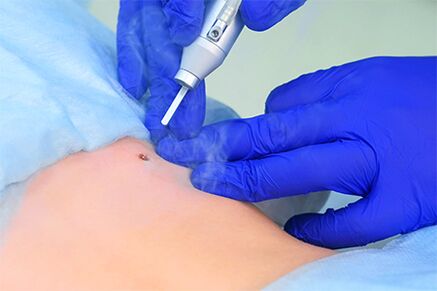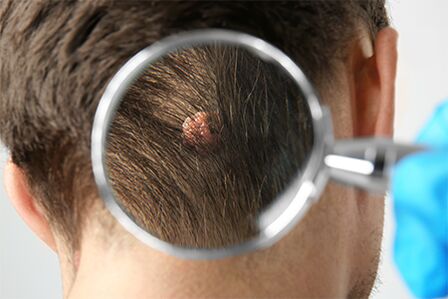A fairly large part of neoplasms on human skin is caused by the activity of the human papillomavirus (HPV). At the same time, papillomas are one of the most common. The virus not only causes this neoplasm to appear, but also gave it a name. But not all patients today know what papilloma is. If you are one of these people or just want to know more about this malignancy, then this article is for you. In it we will talk about papillomas: what it is, what symptoms it has, for what reasons it is formed and how it is treated

Papillomas - what is it
Papillomas are small neoplasms that have the same color as healthy skin or are slightly different from it. Neoplasms can appear both singly and in multiple rashes. Depending on the species, they can be flat, pedunculated, in the form of elongated papillae. These neoplasms can be located almost anywhere: genitals, face, neck, armpits, limbs, etc.
It is also worth noting that papillomas are benign neoplasms. That is, they do not belong to oncological tumors. However, doctors do not recommend leaving them as they are.
Papillomas usually do not hurt, but in some cases they can itch, peel off, cause a slight tingling and / or redness. If the papilloma is located in the intimate area, it can cause discomfort when moving.
Types of papillomas
The five most common types of papillomas are:
- Simple. It looks like a cockscomb or cauliflower.
- Apartment. Such a neoplasm is a flat lump located on the surface of the skin. It can also form in the cervix.
- Filiform. Most often they are found on thin skin and are elongated nodules. It is usually found in people over the age of 50.
- Pointed. Or warts. Transmitted sexually, and therefore most often formed in the genital area. They can appear one at a time or several at once. In this case, they can merge into one large papilloma. They also differ in that they form not only on the surface of the genital organs, but can also grow inside the urethra or cervix.

Why does papilloma appear
As we wrote above, the main reason for the appearance of papilloma is the activity of the human papillomavirus. It is worth noting that according to WHO, today about four out of five people (or even more) are infected with papillomavirus. This is due to several reasons:
- The virus is very resistant. Once infected, it is nearly impossible to get rid of it.
- The virus is easily transmitted. Sometimes even one use of a toilet seat or towel is enough to get infected. And unprotected sex has an almost one hundred percent chance of infection.
- The virus is congenital. Very often the virus is transmitted from mother to newborn, so much so that many people are born with the papillomavirus already acquired.
In general, while our immunity does not destroy the virus, it can suppress it well. That's why cancers don't appear in all infected people. But if the immune system weakens, papilloma (or another malignancy caused by HPV) can appear. There are other factors that can favor the formation of papilloma:
- Stress and emotional stress.
- Senior age.
- Alcohol abuse, smoking.
- Excessive physical activity.
- Lack of vitamins in the body.
- some other diseases. For example, endocrine diseases.
- Taking certain medications (oral contraceptives, immunosuppressants).
- Promiscuous sex life.
After the virus has entered the body, the external manifestations of the papilloma do not appear immediately. Depends on what? By the state of immunity and the duration of the incubation period (from a couple of weeks to several years). Therefore, with a good immune protection status, the first manifestations can appear even after a year. In this case, a person can be infected with several strains of HPV at once (there are about 170 of them).
papilloma treatment
Of course, not everyone knows what papillomas are and how to treat them. And some even believe that there is no need to treat them, since these neoplasms are benign. Doctors have a different opinion on this matter: papillomas should be treated, and it is advisable not to postpone treatment. So why should this benign neoplasm be treated? First, the papilloma can turn into a malignant neoplasm. Especially under the influence of some factors. For example, due to intense ultraviolet radiation, injury, inflammation. Secondly, the neoplasm negatively affects the female reproductive function. If the woman goes untreated and becomes pregnant, it is very likely that the virus will be passed on to the newborn. Thirdly, the papilloma located in the throat or trachea can make breathing difficult or even cause suffocation. Fourthly, as already mentioned, the papillomavirus is transmitted quite easily and therefore an untreated neoplasm can be very contagious. Fifth, neoplasms can cause aesthetic discomfort.
Types of papilloma treatment
It should be noted right away that you cannot resort to self-medication. Only a specialist with a medical education knows exactly how to diagnose papillomas, what it is and how it is treated. At the same time, it should be remembered that when removing any neoplasm, it is recommended to send the excised tissue for histological examination.
Speaking of treatment, today you can choose several ways to get rid of the neoplasm.
- Surgical excision. The operation is performed under local anesthesia. The neoplasm is removed with a scalpel along with the adjacent healthy tissue. Because of this, the healing process can take a long time. Also, there is a high probability of scarring at the excision site. For these reasons, this procedure is currently performed quite rarely. Mainly in cases where other methods fail or when the tumor is too large.
- Cryodestruction. This is the name of the procedure for exposing tissues to ultra-low temperatures. Most often, the procedure is performed using liquid nitrogen, which has a temperature of -196 ° C. As a result, the water in the cells at the site of exposure freezes and the neoplasms die. The disadvantages include low efficiency (about 60%), since with insufficient freezing, the neoplasm will not receive enough damage. And with excess - healthy tissue will be damaged.
- Electrocoagulation. This is the name of the procedure for cauterizing neoplastic tissue with an electric current. Of the minuses, they name the pain of the procedure and the likelihood of skin scarring at the site of exposure. But the efficiency is quite high - about 95%.
- Removal of the neoplasm by laser. The essence of the procedure is the effect of a laser beam on the tissue. As a result, the neoplasm is evaporated layer by layer. The adjustable power allows you to remove the papilloma with almost 100% efficiency. And high accuracy allows you to exclude damage to healthy tissue. Today, laser removal is considered by many experts to be one of the most effective ways to get rid of papilloma. After the procedure, there are practically no scars, a long recovery period is not required, and since an application anesthetic is applied before the session, the procedure is quite comfortable for the patient.
In the clinic, laser removal of papillomas is performed using modern devices. No preparation for laser removal is required. But you will need to make an appointment with a laser therapist. At the appointment, the doctor will tell you what papillomas are and how the session will go. The patient will also be checked for contraindications.
The procedure itself goes quite quickly: for single neoplasms, a few minutes are enough, for more - 15-20. After the procedure, the specialist will tell you about proper care. According to the general instructions, it is impossible to sunbathe, go to the bathhouse and sauna during the first two weeks. You will also need to take care of the treated area.
Do not forget about the contraindications to the procedure. Laser removal of papillomas is not performed in the presence of ailments, lesions of the central nervous system and the presence of bleeding.



















